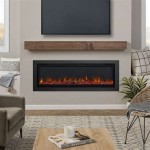Decorative Wall Tiles: Enhancing the Living Room Aesthetic
The living room, often considered the heart of a home, serves as a space for relaxation, entertainment, and social gathering. Its design profoundly impacts the overall ambiance and perceived value of the property. Among the various design elements available, decorative wall tiles have emerged as a versatile and impactful option for transforming the living room's visual appeal and functional characteristics.
Decorative wall tiles encompass a broad range of materials, styles, colors, and textures, offering homeowners a considerable degree of creative freedom in customizing their living spaces. From classic ceramic designs to contemporary glass and stone options, the selection process requires careful consideration of factors such as the existing décor, the size of the room, and the desired level of maintenance. This article explores the advantages, different types, installation considerations, and maintenance aspects of utilizing decorative wall tiles to elevate the living room environment.
Key Advantages of Using Decorative Wall Tiles in the Living Room
The incorporation of decorative wall tiles in the living room presents numerous benefits, extending beyond purely aesthetic improvements. These advantages contribute to both the visual appeal and the practical functionality of the space.
Aesthetic Versatility: Decorative wall tiles offer unparalleled versatility in terms of design possibilities. They are available in a vast array of colors, patterns, textures, and sizes, allowing for the creation of unique and personalized living room spaces. Tile designs can range from minimalist and modern to ornate and traditional, accommodating diverse aesthetic preferences. Furthermore, tiles can be used to create focal points, highlight architectural features, or add visual interest to otherwise plain walls. For example, a textured tile backsplash behind a fireplace can instantly transform the area into a stunning centerpiece. Similarly, a mosaic tile accent wall can add a touch of artistry and sophistication to the room. This flexibility in design allows homeowners to customize their living rooms to reflect their individual style and personality.
Durability and Longevity: Compared to other wall covering options such as paint or wallpaper, decorative wall tiles offer superior durability and longevity. They are resistant to scratches, stains, moisture, and fading, making them ideal for high-traffic areas like the living room. High-quality tiles can withstand daily wear and tear, maintaining their appearance for many years with minimal maintenance. This durability translates to a long-term investment, as tiles require less frequent replacement compared to other wall covering materials. The resistance to moisture also makes tiles a suitable option for living rooms that are prone to humidity or spills. Furthermore, certain types of tiles, such as porcelain, are particularly resistant to temperature fluctuations, making them appropriate for rooms with fireplaces or large windows that receive direct sunlight.
Easy Maintenance and Cleaning: Maintaining decorative wall tiles is generally straightforward and requires minimal effort. Most tiles can be easily cleaned with a damp cloth and mild detergent. Their non-porous surface prevents the absorption of stains and spills, making them easy to wipe clean. Unlike wallpaper or painted walls, tiles do not require repainting or special cleaning solutions. This ease of maintenance is particularly beneficial in the living room, where spills and stains are common. The durability of tiles also means that they are less susceptible to damage from cleaning, further simplifying the maintenance process. Regular cleaning helps to preserve the appearance of the tiles and prevent the buildup of dirt and grime, ensuring that they continue to enhance the beauty of the living room for years to come.
Increased Property Value: The addition of decorative wall tiles, particularly high-quality and aesthetically pleasing designs, can significantly enhance the perceived value of a property. Buyers often appreciate the durability, low maintenance, and visual appeal of tiled walls, making them a desirable feature in a home. A well-designed and executed tile installation can elevate the overall aesthetic of the living room, creating a more inviting and sophisticated space. This can translate into a higher selling price and increased marketability for the property. Furthermore, the longevity of tiles means that they will likely remain in good condition for many years, further adding to the long-term value of the investment. The perceived value is also influenced by the type of tile used; natural stone tiles, for example, often convey a sense of luxury and sophistication that can positively impact property valuation.
Types of Decorative Wall Tiles Suitable for Living Rooms
The market offers a diverse range of decorative wall tiles, each with unique characteristics and aesthetic qualities. Selecting the appropriate type of tile requires careful consideration of the desired style, budget, and functional requirements of the living room.
Ceramic Tiles: Ceramic tiles are a popular and versatile choice for living room walls. They are relatively affordable, durable, and available in a wide range of colors, patterns, and sizes. Ceramic tiles are manufactured from clay that is fired at high temperatures, resulting in a hard and water-resistant surface. They are suitable for both dry and moderately humid environments, making them a practical option for most living rooms. Ceramic tiles are also easy to clean and maintain, requiring only regular wiping with a damp cloth. The versatility of ceramic tiles allows for the creation of various design styles, from minimalist and modern to rustic and traditional. They can be used to create accent walls, backsplashes, or even cover entire walls for a dramatic effect. However, ceramic tiles are generally less durable than porcelain tiles and may be more susceptible to chipping or cracking under heavy impact.
Porcelain Tiles: Porcelain tiles are a denser and more durable alternative to ceramic tiles. They are manufactured from a finer clay and fired at higher temperatures, resulting in a harder, less porous, and more water-resistant surface. Porcelain tiles are highly resistant to scratches, stains, and fading, making them ideal for high-traffic areas and rooms that are exposed to moisture. They are also suitable for both indoor and outdoor applications, providing greater design flexibility. Porcelain tiles are available in a wide range of colors, patterns, and textures, including options that mimic natural stone, wood, and concrete. Their superior durability and aesthetic versatility make them a popular choice for luxury living rooms. While porcelain tiles are more expensive than ceramic tiles, their longevity and low maintenance requirements can make them a cost-effective investment in the long run. They are particularly well-suited for living rooms with fireplaces or large windows that receive direct sunlight, as they are resistant to temperature fluctuations.
Glass Tiles: Glass tiles offer a sleek and contemporary aesthetic that can add a touch of elegance and sophistication to the living room. They are available in a variety of colors, shapes, and sizes, including mosaic tiles, subway tiles, and large-format tiles. Glass tiles are non-porous and resistant to stains and moisture, making them easy to clean and maintain. They also reflect light, which can help to brighten up the room and create a more spacious feel. Glass tiles are often used to create accent walls, backsplashes, or decorative borders. They can be combined with other types of tiles to create unique and visually appealing designs. However, glass tiles are generally more expensive than ceramic or porcelain tiles and may be more susceptible to scratching. They also require careful installation to avoid chipping or cracking. The translucent nature of glass can also make imperfections in the underlying surface more visible, so proper surface preparation is essential.
Stone Tiles: Natural stone tiles, such as marble, granite, slate, and travertine, offer a timeless and luxurious aesthetic that can enhance the beauty of any living room. Each type of stone has unique characteristics and visual appeal, ranging from the elegant veining of marble to the rustic texture of slate. Stone tiles are durable and long-lasting, but they require regular sealing to protect them from stains and moisture. They are also more expensive than ceramic or porcelain tiles. Stone tiles can be used to create a variety of design styles, from classic and traditional to modern and contemporary. They are often used to create focal points, such as fireplace surrounds or accent walls. The natural variations in color and texture of stone tiles add depth and character to the living room. However, the porous nature of some stone tiles means that they are more susceptible to staining and require more frequent cleaning than other types of tiles. The weight of stone tiles can also be a factor, requiring stronger subfloors and professional installation.
Installation and Maintenance Considerations
Proper installation and maintenance are crucial for ensuring the longevity and aesthetic appeal of decorative wall tiles in the living room. These aspects directly impact the overall visual impact and the long-term durability of the tiled surfaces.
Professional Installation: While DIY tile installation is possible, professional installation is generally recommended, especially for complex designs or large-format tiles. Professional installers have the experience and expertise to ensure that the tiles are properly aligned, leveled, and grouted. They also have the necessary tools and equipment to handle the job efficiently and effectively. Improper installation can lead to uneven surfaces, cracked tiles, and water damage. Furthermore, professional installers can provide valuable advice on the selection of appropriate adhesives, grouts, and sealants for the specific type of tile being used. The cost of professional installation may be higher than DIY, but the long-term benefits of a properly installed tile surface outweigh the initial expense. A professional installation also provides peace of mind, knowing that the job has been done correctly and that the tiles will remain in good condition for many years.
Surface Preparation: Proper surface preparation is essential for ensuring a successful tile installation. The wall surface must be clean, dry, and level before tiles can be applied. Any existing paint, wallpaper, or adhesive residue must be removed. Uneven surfaces should be leveled with a patching compound. In some cases, it may be necessary to install a backer board to provide a stable and moisture-resistant surface for the tiles. Failure to properly prepare the surface can result in tiles that do not adhere properly, leading to cracking or detachment. The type of surface preparation required will depend on the existing wall material and the type of tile being used. For example, concrete walls may require a different preparation process than drywall walls. Consulting with a professional installer can help to determine the appropriate surface preparation techniques for the specific project.
Regular Cleaning: Regular cleaning is essential for maintaining the appearance of decorative wall tiles. Most tiles can be easily cleaned with a damp cloth and mild detergent. Avoid using abrasive cleaners or scouring pads, as these can scratch the surface of the tiles. For stubborn stains, a specialized tile cleaner may be necessary. It is important to follow the manufacturer's instructions when using any cleaning product. The frequency of cleaning will depend on the amount of traffic and the type of tile being used. For example, tiles in high-traffic areas may require more frequent cleaning than tiles in less frequently used areas. Regular cleaning helps to prevent the buildup of dirt and grime, ensuring that the tiles continue to enhance the beauty of the living room for years to come.
Grout Maintenance: Grout, the material that fills the spaces between tiles, is susceptible to staining and discoloration. Regular cleaning with a grout cleaner can help to prevent this. In some cases, it may be necessary to reseal the grout to protect it from moisture and stains. Grout sealers are available in a variety of types, including penetrating sealers and surface sealers. Penetrating sealers are absorbed into the grout, providing long-lasting protection. Surface sealers create a protective layer on the surface of the grout, making it easier to clean. The type of grout sealer required will depend on the type of grout used and the level of protection desired. Over time, grout may become cracked or damaged. Damaged grout should be repaired or replaced to prevent water damage and maintain the appearance of the tiled surface. Professional grout repair services are available to address more challenging grout problems. Regular grout maintenance will help to prolong the life of the tiled surface and maintain its aesthetic appeal.

20 Beautiful Wall Tiles Ideas For Living Room Design Floor Tile

Living Room Wall Tiles Designs For Your Home Design Cafe

Living Room Wall Tiles Designs For Your Home Design Cafe

Decorative Kitchen Tiles Ivory Decor Betahome

Cheap Decorative Wall Tiles For Sitting Room Manufacturers And Suppliers Wholesale Price Hanse

Living Room Wall Tiles Designs For Your Home Design Cafe

Living Room Wall Tiles Best Design Wholesale Supplier

Factory Price Living Room Decorative Floor Wooden Ceramic Tile Tiles Rustic Made In Com

Teak Wood Decorative Mosaic Wall Tiles

Acoustic Panel Decorative Wall Tiles Mix And Match To Etsy








